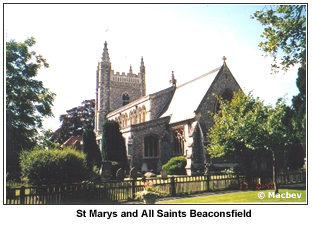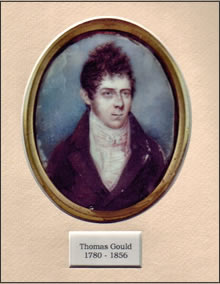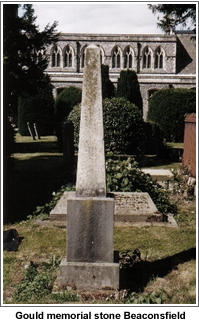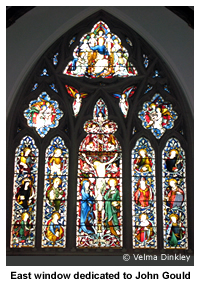Putting the flesh on the bones of my husband’s great x2 grandfather, the Rev. John Gould, B.D. took several years, some creative research, technological advances in the I.T. world and a trip to the UK. At times, it seemed like a tale lifted straight from Jane Austen, although without the customary romantic ending.
He was the twin son of Nicholas Gould and Mary Stillman, born 1st September 1780, in Trowbridge, Wiltshire. By birth, he was connected to many distinguished English families. Those connections were commemorated in unusual names persisting through generations of Goulds. When I eventually made contact with an American Gould, descended from the Rev. John’s twin brother, we were to find his branch also proliferated with Husey/Husseys, Wentworths and Churchills.
Great Expectations
John’s father, Nicholas, who had succeeded to the West Stafford estate of Frome Billet on the death of his brothers, also inherited substantial property from his sister Elizabeth, the Countess of Stafford. He raised a family of six sons and one daughter, who followed a pattern common to English county families. The elder twin son, Thomas, was a captain in the Dorset Militia; the younger twin, John, followed the academic pathway, graduating from Trinity College, Oxford, on 6th December 1798, then proceeding to Magdalen College, also in Oxford, in 1799, where he became a Bachelor of Arts in 1802, a Master of Arts in 1805, a Bachelor of Divinity in 1814, and a Fellow between 1808-1819.
John became vicar of the church at New Shoreham, Sussex, in 1816, and in 1818, he became the rector of St Mary’s and All Saints in Beaconsfield, Buckinghamshire, which living he held until his death on 14th September 1866. John seems to have been very proud of his academic attainments, as he invariably signed himself with the superscription ‘B.D.’

Of the other siblings, one became a professional soldier, serving in the Peninsular War of 1808-1814, and another became a commander in the Royal Navy. The youngest brother emigrated to Canada, whilst the only sister died unwed at the age of 28. All were to predecease John.
Probably feeling secure after gaining the living in Beaconsfield, John married Mary Wellsteed on 18th September 1818, at Calbourne, Isle of Wight, and promptly set about raising a large family, with the birth of Mary (1819), Elizabeth Hussey (1822), Susannah (1823), Alice (1825), the only son, John Henry (1826), Gertrude Stirling (1830) and Emily Wentworth (1834-1835).
Nicholas Gould, his father, died in February 1823 and by the terms of his will, desired his trustees to sell his estate at Frome Billet, the proceeds to be divided among his six sons. Somehow, John contrived to purchase the property, which he held until 1830, when it passed out of the Gould family forever.
These were the bare facts of John’s life, gleaned from family anecdotes, census images, and a lengthy pedigree, drawn up by the Heralds’ Visitations of Devon and Dorset, updated by a cousin of the Rev. John, which was in the possession of my American friend who kindly shared it with me.
However, there were issues that puzzled me, the answers to which were to prove very elusive. Why, for instance, was there no trace of the Gould family in Beaconsfield in 1841, although I found them on every subsequent census? Why was a stranger listed as the incumbent at the rectory at a time when all the authorities agreed John Gould held the living? Why did the eldest twin Thomas not inherit the family estates? Why did Thomas’ two sons become tradesmen? Why did the Goulds lose Frome Billet?
The answers trickled in slowly, involving much use of the internet, a visit to Beaconsfield in 2001 and access to newly digitised newspapers this year. The story is still unfinished, but I have a clearer understanding now of the decline and fall of the family.
Debts and Disputes
The first clue was the will of Nicholas Gould. I have still not deciphered all the legalese of this document, but it is obvious he intended his assets to be shared equally between his six surviving sons. In a codicil to this will, there is a reference to the debts of the eldest, Thomas, which were to be paid out. Aha I thought… ye classic wastrel son!
With the aid of my American friend, I had discovered that Thomas had made an ‘unsuitable’ marriage, at the age of 66, to 25 year old Ann Longhurst, the daughter of a wheelwright. The marriage took place on the 24th November 1846; three days later, the birth of their son, Edward Wentworth Gould, was registered. A second son, Frederick Wentworth Gould, was born in 1848. The marriage and both births had been duly entered on the Gould pedigree by Thomas’ genealogist cousin, Hubert Churchill Gould, and circulated to both the American and Australian branches of the family.
The next clue came when I bought an Ancestry UK subscription and had the opportunity to browse the 1841 census in depth. I was bemused to discover that the Queens Bench Debtors’ Prison listed both a Captain Thomas Gould and a John Gould, cleric, of the approximately correct age, as inmates on the night in question. At this point, I was uncertain of the operations of debtors’ prisons, and given the distinguished nature of some of the other names listed, wondered if the governor of the prison had been entertaining guests. I filed the information away for future reference and went onto find the Rev. John’s two youngest daughters, Alice and Gertrude, at school in Brighthelmstone, Sussex, now present day Brighton, and found possible ‘sightings’ of the other girls in other educational institutions. Of John’s wife Mary, I could find no definitive trace.

In 2001, I visited the UK and looked up Gould family locations in Upwey and West Stafford, Dorset, happily photographing Upwey Manor, the local churches where Goulds had been buried, and Stafford House (Frome Billet).
Almost as an afterthought, in the last few days before our departure, we went to Beaconsfield to visit St Mary’s and All Saints church. Whilst reading the visitors’ information brochure there, I fell into conversation with a parishioner who had come to arrange the flowers. When she learned of our connection with the former rector, she said that we should seek out the present incumbent who lived in the rectory next door, whom she insisted would be most interested.
It was lunchtime and I was reluctant to disturb a busy man, but urged on, we approached the beautiful old rectory, knocked on the door, and were warmly received by the rector. Imagine how my jaw dropped when after my first few words of explanation, he responded with the startling comment, “Oh, old John Gould, who was sent to Newgate Debtors’ Prison”.
When I remembered to close my mouth and accepted the invitation to come into the rector’s study, I was given a book, A Guide to the Parish Church of St Mary and All Saints, Beaconsfield, by Canon Arthur A. Jones, which stated:
“Later, he (GOULD) fell into debt, and was committed to Newgate Debtors’ Prison. The churchwardens could not find priests to help in the Parish, and the authorities were persuaded to allow him out of prison each weekend to conduct the services, provided that he returned to Newgate during the week. This arrangement continued until his death in 1866”.
I have been unable to trace the source of the Canon’s information, so cannot confirm its accuracy, especially when I noticed that he had been inccurate with other information relating to the family.
However, I have recently been able to confirm that John was indeed imprisoned c1837, by the discovery of two newspaper articles.
The first, printed in Jackson’s Oxford Journal, on August 5th, 1837, was basically an appeal to the Rt Hon Lord Denman, Lord Chief Justice of the Queen’s Bench, which cites the provisions of the Magna Charter, disputing the power to arrest or imprison any man for debt. The article concludes with a stirring appeal:-
“The time has come when the question must be settled – when the English Bastile must be destroyed –when nearly 20,000 persons must be redeemed from heartless, useless captivity, and from privation, degradation, ruin, and lingering suffering. – We, therefore, again solicit your Lordship to consider the question as paramount, not only on account of the number now incarcerated, but from the consequent desolation of their families, and the great destruction of their avocations, and also on account of the great constitutional question it involves”.
Heading the list of the signatories was J.Gould, B.D. Rector of Beaconsfield, Bucks.
The reference to the distress caused to debtors’ families is reinforced by an article printed in the The Ecclesiastical Gazette, 1839:-
“The Rev. John Gould has been incarcerated for debt upwards of twelve months, with little prospect of his being liberated: his benefice has been sequestered for his creditors, leaving no chance for some years of his deriving any income therefrom: he has left a wife and six children without any means whatever of obtaining the ordinary necessaries of life, who have hitherto be supported by voluntary contributions, and are still depending upon the same precarious means. If timely aid be not afforded to this distressed family, they will be driven to make application to parochial authorities. It is therefore sincerely hoped that the friends of the family and the public will deeply interest themselves in such a case of real distress: and that, through their substance, a sum may be placed at the disposal of the Committee, sufficient to realize the objects of this appeal from their state of total indigence, and thus prevent the degradation of a Clergyman’s family, which might otherwise result. The anxious attention of the Committee will be directed to the education of the children of Mr. Gould.”
Alas, from the evidence of the 1841 census, it does not seem that the appeal to Lord Denham was successful, although the subsequent appeal for funds to educate his children must have met with a more positive response.

I have not yet been able to determine what caused the catastrophe. John Gould had been engaged in disputes with some of his parishioners over tithing practices. I am obliged to Canon Jones for the following comments:-
“He (GOULD) quarrelled violently with local farmers about the payment of tithes, and with the church wardens and with the Archdeacon about the commissioning of church repairs and the settling of accounts. As a result of losing several court cases he was compelled to accept with the local farmers the terms of the judgement given by Lord Ellenborough.
The farmers considered that they had won a notable victory, and they set up a small pillar on the farm of JOHN ROLFE with the terms engraved upon it.”
The farm has gone, but the stone can still be seen on the A40 near North Drive, Holtspur, and it states:-
“3rd May 1827. Boundary stone of the Manor and Parish of Beaconsfield. The custom of tithing corn in this Parish is (and has been so immemorially) by the TENTH COCK and the ELEVENTH SHOCK”.
When we read this we immediately set out along the A40 to find the boundary stone, and after a certain amount of hunting about in the hedges, discovered and photographed it.
Perhaps as a consequence of losses incurred in this unsuccessful court case, the West Stafford property was listed for sale in The Times on 15th July 1830.
“Dorsetshire – The fine estate of Frome, with its manors and excellent trout fishery, delightfully situate, within 2 miles of the county town of Dorchester, and within a short drive of Weymouth, surrounded by the preserves of Moreton Pitt Esq, Mrs Floyer and the late Lady Caroline Damer.
By Daniel Smith & Sons at the Mart, Wed Aug 18th in 1 lot, unless acceptable offers shall be previously made for the estate, together or in lots, parts being eligible for building.
The above very valuable freehold property, beautifully situated, at the opening of a rich vale near Dorchester; comprising Frome House, a comfortable and highly respectable family seat, with its various appendages, lawns and gardens, surrounded by about 550 acres in a ring fence of exceedingly rich land forming one of the best farms in the county, of which about 178 acres are remarkably fine water meadows, and the remainder excellent arable; particularly adapted to the turnip system, with respectable farmhouses and buildings of every description. The estate abounds with game of all kinds and a beautiful trout stream intersects the property, expanding into a small lake, the favourite resort of wild fowl, near the mansion, affording to a sportsman attractions at all seasons of the year. The estate may be viewed with cards and descriptive particulars, with plans, may shortly be had at the inns at Dorchester and Blandford; at the libraries, Weymouth and Salisbury, at the Mart; of Messrs E.G. Smith & Son, Solicitors, Angel Court, Throgmorton Street and of Daniel Smith & Son, land agents and surveyors, Alderman’s Walk, New Broad Street, London and Windsor,Berks”.

It took us some time to locate this house, with some difficulty caused by us looking for a village called Frome Billet, which as we now have discovered is known as West Stafford. A hasty visit to the Dorchester Record Office gave the vital clue, however, and we managed to locate this delightful little village and take plenty of pictures, not only of Stafford House, as it was now known, but of the interesting church there with its memorials to various members of the Gould family.
John Gould’s problems must have been compounded about this time by what looks suspiciously like the wastrel habits of his twin. In a copy of The Satirist on November 13th, 1831, there is an article referring to one Thomas Gould, a captain in the Dorset Militia, insolvent, and with debts of nearly £30,000, apparently living on ‘expectations’.
Perhaps with this history of financial embarrassment, it is not surprising that I discovered in John Bull on February 17th, 1844, an article which referred to the liberation of a Mr Oastler from the debtors’ prison, together with an appeal for subscriptions from the public to purchase an annuity for the said Mr Oastler. Captain Gould appears on the Committee, where also a J. Gould, B.D. was acting as Honorary Secretary. I have no idea who Mr. Oastler was, but Thomas and John were obviously empathetic to his problems.
Two of John’s daughters were wed at Beaconsfield; Susanna in 1848, to John Rennie, of Auchinloch, the Justice of the Peace for County Lanark, and Alice, in 1849, to William Mitchell of Craigleith House, Edinburgh. Both marriages produced children, which possibly was the last unalloyed pleasures granted to the Rev. John.
Deaths and departures

The year 1852 was an ‘annus horribilus’ for the Goulds.
At Addison Terrace, Notting Hill, London, malignant scarlet fever struck the Rennie family. First to succumb was the eldest child, Robert Gould Rennie, who died on the 30th May, followed in quick succession by his father, John Rennie, on the 5th June, his mother, Susan on the 7th and finally, his aunt, Mary Gould, on 10th June, who had come to nurse the stricken family.
The family was interred in the graveyard at St Mary’s and All Saints, Beaconsfield, with the following inscriptions on the obelisk mounted on the grave:-
“In memory of John Rennie Esq., of Auchinlock, interred, who died 6th June 1852 aged 35 years, also of Susanna his wife, daughter of John Gould B.D Rector of this Parish. She died 7th June in the 28th year of her life, and of their eldest child Robert Gould Rennie who died 30th May 1832 aged 3 years.
Not lost but gone before.
In this same grave are deposited the remains of Mary, eldest daughter of John Gould, B.D., who hastened to attend her suffering relatives and fell a sacrifice to her devotion. Aged 32 years.
Blessed are the …. in the Lord”.
Canon Jones was of the opinion that these successive blows left John Gould a broken man, unable to attend to his financial affairs and thus resulting in his insolvency. Whilst it is probably true that the Reverend was not able to conduct his parish affairs very efficiently in the aftermath of this tragedy, his financial problems had in fact occurred much earlier.
Rev. John’s only son, John Henry, graduated from Merton College, Oxford, in 1849, and was gazetted as a lieutenant in the Dorset Militia in 1852. Although, if his genealogist cousin Hubert Churchill Gould is to be believed, he did not stay around long enough to take up his position, but instead emigrated to Australia in September of that year, possibly with the intention of restoring the family fortunes on the Bendigo goldfields.
In the event, he eked out a living as a ‘gentleman farmer’, with no notable success, marrying a young emigrant, whose father had been a sawyer and her mother a laundress. None of which deterred John Henry, or his son, from describing himself as a ‘gent’ or handing down through the family the tales of past glories.
Further disputes and deaths
It seems as though John’s next surviving daughter, Elizabeth Hussey, came to exercise dominance in the family after the deaths of her sisters and the departure of her brother. An account in the Bishops’ and Registars’ Memoranda, Accounts and Correspondence from the Diocese of Oxford, described how in the mid to late 1850s, John Gould was in dispute with the new curate at St Marys and All Saints who had refused to be dictated to by Gould’s daughter and consequently complained to Bishop Wilberforce.
In June 1858, Bishop Wilberforce wrote
“Mr Gould writes that he wishes to part with Major. I remonstrate. Gould asks for an interview. He comes with daughter Hussey, who complains a long-winded complaint of ill will, mischief, etc, while old Gould sits by and reads my papers!”
1859 was another bad year. John Gould’s daughter Alice died in February of that year, of scarlet fever, together with her eldest daughter Mary, aged 4 ½ years. John’s long-suffering wife Mary died on August 23rd and was interred in the family grave. Her death had been preceded a week earlier by that of John’s last surviving brother.
John had been occupying himself with seeking restoration of the tombs and monuments of Edmund Burke, the statesman, and Edmund Waller, the poet. His activities allowed him to associate with the aristocracy, which he must have found gratifying.

He died on the 14th September 1866, after 46 years as the longest serving rector of St Mary’s, and was interred in the family grave. Canon Jones informs us of the memorial window placed in St Mary’s and All Saints:-
“The Chancel is dominated by the East Window, designed and created by John Hardman. The window is dedicated to the memory of Rev. John Gould and his grandson, William Rennie (d. 1867, aged 17).
It has a central motif of the Crucifixion, with the Virgin Mary and St. John on either side. On the left side are six female saints: Cecilia, patroness of music, Frideswide, patroness of Oxford, Margaret of Antioch, Catherine, virgin-martyr, Helena, mother of Constantine, and Mary Magdalene with her bottle of perfume. On the right side are six male saints: Peter, Benedict, Edmund, Augustine, Laurence and Sebastian. At the apex Christ sits throned in glory, blessing the world, with the Archangel Gabriel holding a Madonna lily, on his right, and the Archangel Michael with sword on his left. They are attended by five angels with censers. The window cost £330, of which Miss Gould (Elizabeth Hussey) paid £110″.
John’s death was reported widely in the newspapers of the time, including The Pall Mall Gazette of 1st October 1866 where I found his obituary:-
“The death is announced this morning of the venerable Rector of Beaconsfield, the Rev. John Gould, B.D., to whose untiring zeal and watchful care the country is indebted, first, for the handsome restoration, and next, for the excellent preservation, of the tombs and monuments of Edmund Burke and Edmund Waller, whose names are inseparably linked with Beaconsfield. Mr Gould came of a very old West-country family, and was the son of Mr. Nicholas Gould, of Frome Bellet [sic] and Milborne St Giles’, Dorsetshire. He was born September 1, 1780, was educated at Winchester School and Trinity College, Oxford, whence he was elected demy of Magdalen College under the patronage of the celebrated Dr. Routh, and graduated B.A. in 1804, proceeding M.A. as Fellow in 1807, and B.D. in 1816. He took in 1818 the college living of Beaconsfield as Fellow of Magdalen, and in that year married Mary, daughter of Mr. John Wellsteed, of Stafford, Dorsetshire. The living is worth about £800 a year, with a population of 1,660.”
He was survived by his two daughters, Elizabeth and Gertrude, and his son John Henry.
Macbev
© Macbev 2008